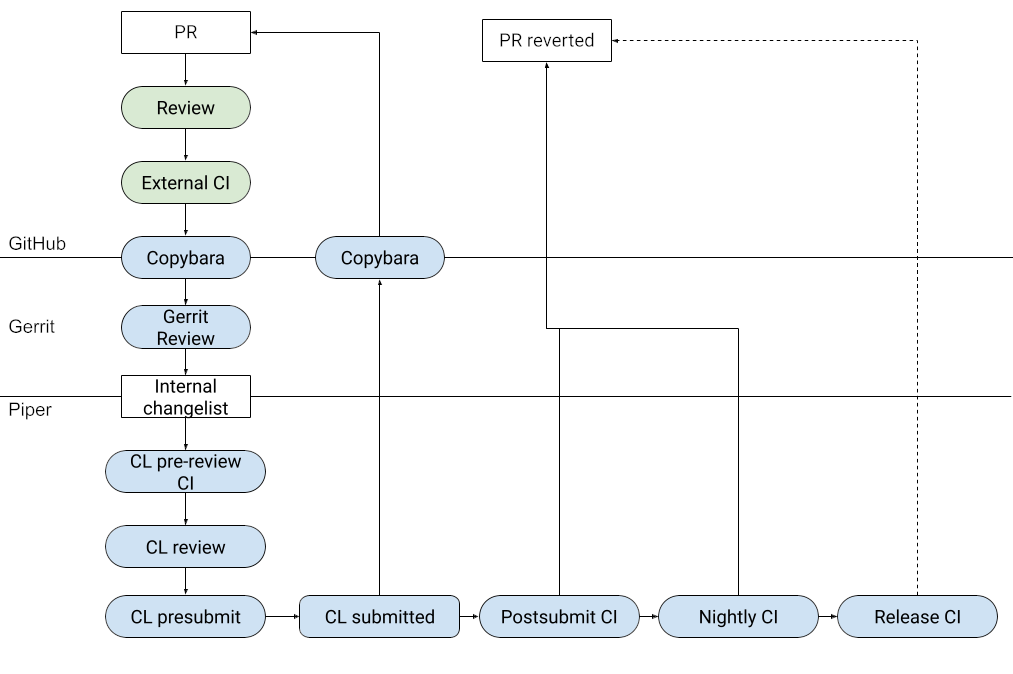- Sort Score
- Result 10 results
- Languages All
Results 71 - 80 of 334 for lite (0.02 sec)
-
cmd/api-errors.go
Code: "XMinioSiteReplicationInvalidRequest", Description: "Invalid site-replication request", HTTPStatusCode: http.StatusBadRequest, }, ErrSiteReplicationPeerResp: { Code: "XMinioSiteReplicationPeerResp", Description: "Error received when contacting a peer site", HTTPStatusCode: http.StatusBadRequest, }, ErrSiteReplicationBackendIssue: {
Registered: Sun Sep 07 19:28:11 UTC 2025 - Last Modified: Wed Apr 16 07:34:24 UTC 2025 - 93K bytes - Viewed (3) -
cmd/admin-router.go
// Cluster Replication APIs adminRouter.Methods(http.MethodPut).Path(adminVersion + "/site-replication/add").HandlerFunc(adminMiddleware(adminAPI.SiteReplicationAdd)) adminRouter.Methods(http.MethodPut).Path(adminVersion + "/site-replication/remove").HandlerFunc(adminMiddleware(adminAPI.SiteReplicationRemove)) adminRouter.Methods(http.MethodGet).Path(adminVersion + "/site-replication/info").HandlerFunc(adminMiddleware(adminAPI.SiteReplicationInfo))
Registered: Sun Sep 07 19:28:11 UTC 2025 - Last Modified: Wed Apr 16 07:34:24 UTC 2025 - 26.7K bytes - Viewed (0) -
src/cmd/asm/internal/asm/endtoend_test.go
} errors := map[string]string{} for _, line := range strings.Split(errBuf.String(), "\n") { if line == "" || strings.HasPrefix(line, "\t") { continue } m := fileLineRE.FindStringSubmatch(line) if m == nil { t.Errorf("unexpected error: %v", line) continue } fileline := m[1] if errors[fileline] != "" && errors[fileline] != line {
Registered: Tue Sep 09 11:13:09 UTC 2025 - Last Modified: Wed Mar 26 01:02:50 UTC 2025 - 11.9K bytes - Viewed (0) -
doc/godebug.md
//go:debug asynctimerchan=0 Starting in Go 1.21, the Go toolchain treats a `//go:debug` directive with an unrecognized GODEBUG setting as an invalid program. Programs with more than one `//go:debug` line for a given setting are also treated as invalid. (Older toolchains ignore `//go:debug` directives entirely.) The defaults that will be compiled into a main package are reported by the command: {{raw `Registered: Tue Sep 09 11:13:09 UTC 2025 - Last Modified: Tue Jul 08 18:30:38 UTC 2025 - 22.9K bytes - Viewed (0) -
helm-releases/minio-3.0.0.tgz
here. storageClass: "" VolumeName: "" accessMode: ReadWriteOnce size: 500Gi ## If subPath is set mount a sub folder of a volume instead of the root of the volume. ## This is especially handy for volume plugins that don't natively support sub mounting (like glusterfs). ## subPath: "" ## Expose the MinIO service to be accessed from outside the cluster (LoadBalancer service). ## or access it from within the cluster (ClusterIP service). Set the service type and the port to serve it. ## ref: http://kuber...
Registered: Sun Sep 07 19:28:11 UTC 2025 - Last Modified: Thu Sep 02 01:47:43 UTC 2021 - 13.8K bytes - Viewed (0) -
docs/site-replication/README.md
export MC_HOST_minio3=https://adminuser:******@****.*** ``` - Add site replication configuration with: ```sh mc admin replicate add minio1 minio2 minio3 ``` - Once the above command returns success, you may query site replication configuration with: ```sh mc admin replicate info minio1 ``` ** Note **
Registered: Sun Sep 07 19:28:11 UTC 2025 - Last Modified: Tue Aug 12 18:20:36 UTC 2025 - 3.4K bytes - Viewed (0) -
docs/debugging/pprofgoparser/main.go
skip, record bool ) for s.Scan() { line := s.Text() switch { case skip && line != "": case skip && line == "": skip = false case record && line == "": stackTrace := bf.String() reset() record = false if searchRE == nil || searchRE.MatchString(stackTrace) { ret[t] = append(ret[t], stackTrace) } case record: save(line) default:
Registered: Sun Sep 07 19:28:11 UTC 2025 - Last Modified: Wed Mar 06 11:43:16 UTC 2024 - 3.4K bytes - Viewed (0) -
cmd/batch-job-common-types.go
func (kv *BatchJobKV) UnmarshalYAML(val *yaml.Node) error { type jobKV BatchJobKV var tmp jobKV err := val.Decode(&tmp) if err != nil { return err } *kv = BatchJobKV(tmp) kv.line, kv.col = val.Line, val.Column return nil } // Validate returns an error if key is empty func (kv BatchJobKV) Validate() error { if kv.Key == "" { return BatchJobYamlErr{ line: kv.line,
Registered: Sun Sep 07 19:28:11 UTC 2025 - Last Modified: Fri Aug 29 02:39:48 UTC 2025 - 7.9K bytes - Viewed (0) -
src/bytes/iter.go
// If s does not end in a newline, the final yielded line will not end in a newline. // It returns a single-use iterator. func Lines(s []byte) iter.Seq[[]byte] { return func(yield func([]byte) bool) { for len(s) > 0 { var line []byte if i := IndexByte(s, '\n'); i >= 0 { line, s = s[:i+1], s[i+1:] } else { line, s = s, nil } if !yield(line[:len(line):len(line)]) { return } } } }
Registered: Tue Sep 09 11:13:09 UTC 2025 - Last Modified: Wed Sep 03 14:04:47 UTC 2025 - 3.6K bytes - Viewed (0) -
CONTRIBUTING.md
to fix this. - Once the internal tests pass, we go ahead and merge the code internally as well as externally on GitHub. In a graphical form, the entire lifetime of a PR looks like  ### Contributor License AgreementsRegistered: Tue Sep 09 12:39:10 UTC 2025 - Last Modified: Sat Jan 11 04:47:59 UTC 2025 - 15.9K bytes - Viewed (0)